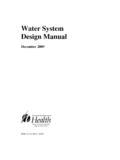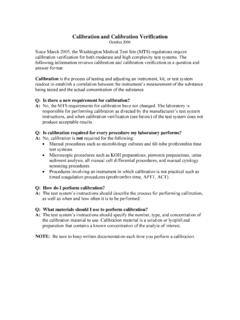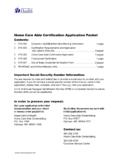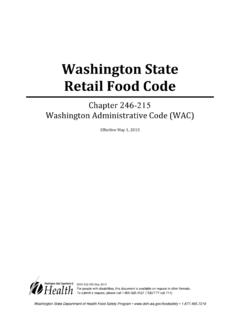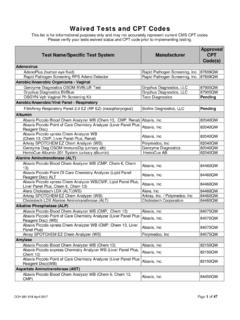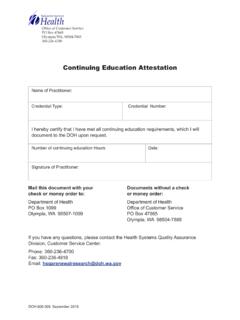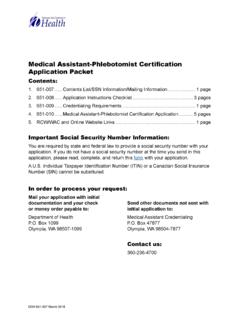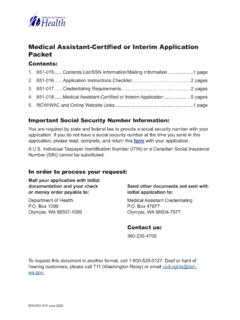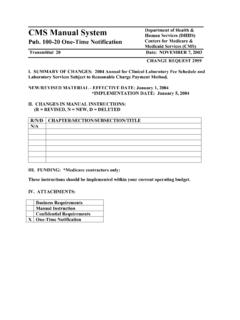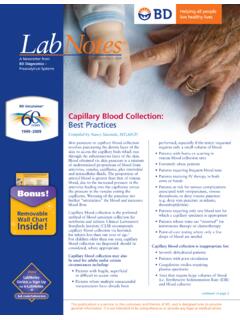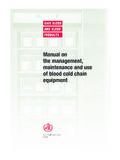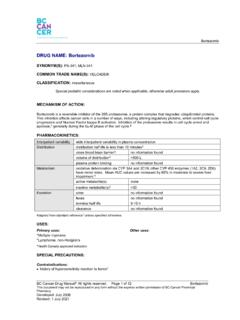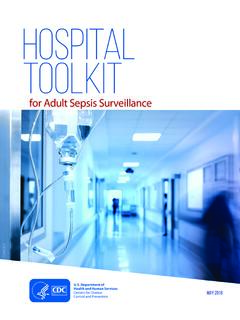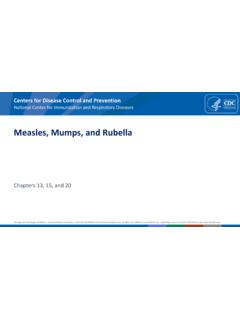Transcription of PT, INR, and APTT Testing
1 Volume XXIII Issue 2 March/April 2018. PT, INR, and APTT Testing by Lori Eschenbacher, BSMT(ASCP)CLS(NCA) tors oral anticoagulant therapy ( , Coumadin). This test Washington State DOH, Lab Quality Assurance may also be ordered for patients suspected of DIC, liver failure, and Vitamin K deficiencies. M. illions of Americans take oral anticoagulant therapy ( , Coumadin). For each of these pa- The PT test evaluates the extrinsic tissue factor pathway tients, the Prothrombin Time (PT), International and common pathways of the coagulation cascade VII, X, Normalized Ration (INR), and Activated Partial Throm- V, II, and I (fibrinogen). The PT test is reported in seconds. boplastin Time (APTT) are the laboratory tests performed to achieve and monitor the appropriate medication dosage. INR: Differences in thromboplastin reagents have caused These tests are also used to assess unexplained bleeding or problems when comparing PT results across laboratories clotting.
2 Due to varying sensitivities of different thromboplastin reagents used in the PT test. This lack of comparability is This article will discuss five basic areas: of special concern for patients who may use more than one 1) basic coagulation terms, laboratory for PT Testing . 2) basic requirements for changing lot numbers, 3) some examples of interfering substances, The World Health Organization has recommended stan- 4) common problems in the collection and processing of dardization of oral anticoagulant monitoring, based on coagulation Testing samples, and expressing PT results in terms of an International Normal- 5) miscellaneous information. ized Ratio (INR). INR calculations are intended to yield Please Note: For single-use devices ( Roche Diagnos- tics CoaguChek, ITC Prothrombin Time Microcoagulation continued on page 2. System, etc.), the laboratory should refer to the manufac- turer's instructions for specimen requirements, procedures, and quality control requirements.
3 Practice Guidelines The following practice guidelines have been devel- 1) Basic Coagulation Terms oped by the Clinical Laboratory Advisory Council. They can be accessed at the LQA website. Prothrombin Time (PT): The PT/INR measures how long it takes for the patient's blood specimen to clot, and moni- Acute Diarrhea Lipid Screening Anemia PAP Smear Referral ANA Point-of-Care Testing Bioterrorism Event Mgmt PSA. Bleeding Disorders Rash Illness Inside This Issue Chlamydia Red Cell Transfusion Diabetes Renal Disease Group A Strep Pharyngitis STD. 2-5 PT, INR, and APTT Testing , cont'd Group B Streptococcus Thyroid 6 Washington's Laboratory Complaint Process/ Hepatitis Tuberculosis HIV Urinalysis Reporting Device-Related Adverse Events to the Infectious Diarrhea Wellness FDA/Calendar of Events Intestinal Parasites 2 ELABORATIONS. PT, INR, and APTT Testing , cont'd from page 1. identical INR results when a single specimen is tested by PT and the PT normal range mean value contain one deci- two laboratories; one using a more sensitive thromboplas- mal place ( , ) and ISI includes two decimal places tin (yielding a higher PT result) and the other using a less ( , ).
4 The INR should be rounded and reported to sensitive thromboplastin (yielding a lower PT result). one decimal place ( , ). The INR result is the patient's PT result in seconds divided ISI: The International Sensitivity Index (ISI) reflects the by the geometric mean of the PT result of the laboratory's sensitivity of the reagent as compared to an international normal patients, as calculated by each laboratory. standard. The manufacturer of the thromboplastin reagent determines the ISI by comparing each batch of reagent to The geometric mean is an average that is different from the a World Health Organization reference plasma and then simple arithmetic average. It is calculated by multiplying assigns an ISI value to that lot of reagent. all the PT results together (in this case, the 20 normal PT. results) raised to the reciprocal of the number of results (in Activated Partial Thromboplastin Time (PTT): The this case, 1/20). The geometric mean is used to avoid bias PTT test is used to reach and maintain therapeutic heparin that may be caused by the inclusion of extremely high or levels and assists in determining bleeding disorders.
5 This low values. A calculator or software program is necessary test may be ordered for unexplained bleeding or bruis- to calculate the geometric mean. ing, DIC, chronic diseases, blood clots, and pre-surgical workups. The INR is calculated from the following formula: INR = (PT patient / PT normal )ISI This test evaluates the intrinsic surface contact and com- mon pathways. The PTT is used to evaluate the coagula- PT patient is the patient's PT result expressed in seconds. tion factors XII, XI, IX, VIII, X, V, II (prothrombin), PT normal is the laboratory's geometric mean value for nor- and I (fibrinogen) as well as prekallikrein (PK) and high mal patients expressed in seconds. molecular weight kininogen (HK). The PTT test is reported in seconds. When performing the calculation, the values for the patient 2) Changing Lot Numbers Requirements for New Lot comparison studies: In ad- ELABORATIONS is a free monthly publication of the dition to manufacturer's requirements, laboratories must Washington State Department of Health (DOH) Public do comparison studies before switching to a new lot of PT.
6 Health Laboratories (PHL) and Office of Laboratory reagent or changing methodology to confirm accuracy of Quality Assurance (LQA). the assigned ISI value. Secretary, DOH: John Weisman, DrPH, MPH. Health Officer: Kathy Lofy, MD These requirements include: Director, PHL: Romesh Gautom, PhD establishing a new normal patient PT mean value, Program Manager, LQA: Susan Walker programming the correct ISI (International Sensitivity Editor: Leonard Kargacin Circulation: Leonard Kargacin Index) into the coagulation analyzer, comparisons between the new and old lot numbers of PT. Comments, letters to the editor, information for publica- reagent, and tion, and requests for subscription can be directed to: documentation of the manual check of the INR calcula- ELABORATIONS tion. 1610 NE 150th St Shoreline, WA 98155. The laboratory must maintain the documentation of the e-mail address: studies, including the raw data, for at least two years. NOTE: Letters to the editor may be published unless Establishing the Normal Patient PT Mean Value: Each specified otherwise by the author.
7 Laboratory must determine the normal PT mean for the Website access: Department of Health Laboratory Quality Assurance Public Health Laboratories continued on page 3. 3 ELABORATIONS. PT, INR, and APTT Testing , cont'd from page 2. patient population it serves in order to calculate an accurate INR. To establish the normal patient PT mean, a minimum of 20. un-anticoagulated healthy patients evenly distributed between males and females should be tested with the new lot of throm- boplastin. Ensure that patients taking interfering substances/medications are not included in the study for the normal patient PT mean. Emergency department or pre-op patients should not be used for the normal patient pool because their blood may contain acute phase reactants that are elevated in times of stress, and inflammation can shorten the normal range. Additionally, Testing should be completed over a period of several days to include intra-lab variability.
8 3) Interfering Substances for Prothrombin Time Please note that certain substances are known to interfere with Prothrombin Time and INR results. Do not select patients tak- ing these substances to establish the new normal patient PT mean value. Substances that may increase Prothrombin Time and INR: Antiiotics Penicillins (except Dicloxacillin, Nafcillin), Doxycycline, Cephalosporins, Fluoroquinolines, Macrolides, Metronidazole, Timethoprim-sulfamethoxazole Medications Acetaminophen, Amidorone, Allopurinol, Amiodarone, Androgens ( , testosterone, methyltestosterone, oxandrolone), Azole antifungals and cancer therapies Alcohol in larger amounts (three drinks per day). Vitamin K. Decreases in vitamin K consumption increases the effect of Coumadin (a significant change in vitamin K consumption may result in a significant change in your Prothrombin Time/INR). Substances that may decrease Prothrombin Time and INR: Vitamin K. Increases in vitamin K consumption decreases the effect of Coumadin (a significant change in vitamin K consumption may result in a significant change in your Prothrombin Time/INR).
9 Antibiotics Dicloxacillin, Nafcillin, Griseofulvin, Rifampin Medications Azathioprine, Cholestryramine, Ritonavir, Sucalfate Note: Herbs and supplements may affect the Prothrombin Time; consult a doctor or pharmacist. 4) Specimen Collection and Variables that Affect Coagulation Testing Pre-analytic procedure failures are the source of many problems in coagulation Testing . The Testing site must adhere to manu- facturer instructions, package inserts, and operator's manuals to ensure adequate specimen collection and processing. Specimen labeling: The CLSI recommends that specimens should be collected, labeled, and stored in a manner that respects patient privacy in accordance with HIPAA. The patient should be positively identified at the time of collection, and speci- mens should be labeled in the patient's presence after the blood is drawn and that each label contains the patient's full name, a unique identifier, date and time of collection, and any other information required by your regulatory agency and your facility.
10 Specimen collection tubes and devices: Use and proper filling of tubes: It is critical that percent citrated tubes are used and filled properly to maintain a ratio of 9 parts blood to one part citrate (9:1). Under-filled tubes will contain an excess of anticoagulant, causing erroneous test- ing results. continued on page 4. 4 ELABORATIONS. PT, INR, and APTT Testing , cont'd from page 3. It is never acceptable to pour partially filled tubes together to make one full tube as this tube will contain too much antico- agulant. Discard tubes: Note: Although discard tubes are no longer required for prothrombin time and partial thromboplastin time, the practice is still recommended for other coagulation studies due to lack of sufficient evidence that discard tubes are not needed. Always check with the manufacturer of your instrument and/or your reference laboratory for the current reco- mmendations. Butterflies and winged devices: If using a butterfly or winged device to draw the sample, a non-additive discard tube should be used if the coagulation tube is the first tube to be drawn.
